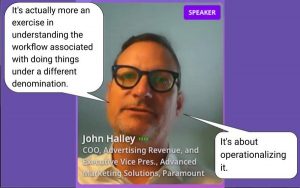Data quality, campaigns/lead management and workflows/integrations are all destined for an upgrade.
This is part one of a four-part series on AI’s infusion into marketing automation platforms.
The rapid adoption of generative AI has increased the excitement volume to 11 for martech professionals. AI-enabled enhancements to the core uses of marketing automation platforms — data management, campaign/lead management and workflows/integrations — are being introduced by Salesforce, HubSpot and other market leaders. They will alter the mix of tasks marketers tackle daily and impact planned improvements to customer experiences and satisfaction.
This quote sums up the scale of AI’s impact:
“Next-gen marketers know that in order to deliver the personalization and experiences modern consumers expect, marketing must become smarter. It must become marketer + machine.”
– Paul Roetzer and Mike Kaput, Marketing Artificial Intelligence
This statement could have applied to the mainstream adoption of marketing automation platforms (MAP) as the original natural language processing for martech. They experienced an inflection point — similar to the one we’re seeing with AI today — of their own 10 years ago. Widespread adoption of marketing automation set the stage for the exponential growth of martech applications, which increased to over 10,000 in 2022 — a 6,000% increase compared to 2011.
Why it matters. New capabilities will emerge by infusing MAPs with AI, further expanding the influence of the foundation of most organizations’ martech stack: core MAP integrated with CRM. Therefore, martech leaders should invest in discovering use cases that can be modified to incorporate new AI capabilities. AI-powered, tried-and-true best practices will drive value in 2023 and beyond.
Here’s how AI will be applied to the three core marketing automation uses. Each of these three will be the focus of a deeper dive follow-up piece over the coming year.
Data quality will be even more important when our data are used to train company-specific AI models.
Underlying data about customers and prospects is table stakes for personalizing marketing. As the amount and variety of data captured increases, it will require re-focused efforts to adjust to more natural language standard values in drop-downs, form fields, etc., to describe customer engagements. AI will enable marketers to understand, process and analyze data more effectively.
Campaigns and lead management. AI will enable new campaign approaches within existing workflows. Generative AI will power these approaches by choosing between content AI integration prompts or asking an AI assistant to help “codify” business processes.
Workflows and integrations. Previously assumed scope limitations for broader operations and orchestration will be tested. If generative AI can help coders correct code, it’s just a matter of time before it can help extend an open API beyond a native Integration.
Native platform integrations were the original natural language for field mappings and workflows between the CRMs and marketing automation platforms. Instead of asking an IT team to build a custom API, we could use natural language software interfaces to set them up.
Although the overall AI trends are moving at an unprecedented pace, re-investing in these core MAP processes will prepare your organization to adapt to these new AI-infused capabilities quickly.
Check back for part two of this series on the AI infusion into data quality.
Can’t wait for more? Check out my presentation at the MarTech Conference next week, “New School, Old School: Navigating the Current Marketing Automation Landscape.”
The post Looking at AI’s rapid infusion into marketing automation platforms appeared first on MarTech.
MarTech(8)
Report Post





